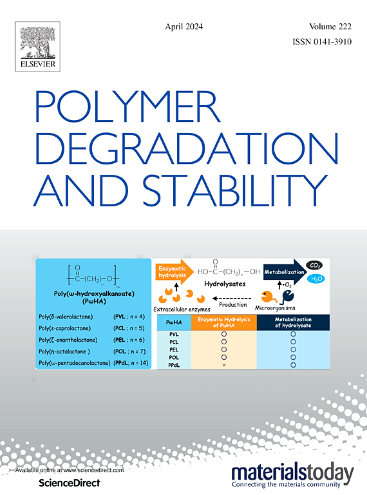Alcohol degradation of anhydride-cured epoxy resin insulations and the properties of recycled materials
IF 6.3
2区 化学
Q1 POLYMER SCIENCE
引用次数: 0
Abstract
Epoxy resins are widely used as electrical insulation materials due to their excellent properties. However, the three-dimensional network structure of epoxy resin makes it difficult to be degraded and recycled, and incineration or landfill will cause environmental pollution as well as waste of resources. In order to study the degradation technology of epoxy insulating materials (EIM) under mild conditions, the degradation of EIM was achieved under mild conditions using K3PO4 as a catalyst in ethylene glycol at 120°C for 3h. Degradation products of epoxy resin insulation materials (DEM) were used to partially replace bisphenol A diglycidyl ether (DGEBA) in the preparation of recycled epoxy resin insulation materials (RIM). The results showed that RIM could maintain good insulating properties when the DEM content was lower than 38.4 wt.%, the tensile strength and Tg were also held up will when the DEM content was 22wt.%. This study provides new ideas and methods for the recycling of epoxy resin insulating materials, which can help the resourceful reuse of epoxy cast electrical equipment after decommissioning.酸酐固化环氧树脂绝缘材料的酒精降解和再生材料的性能
本文章由计算机程序翻译,如有差异,请以英文原文为准。
求助全文
约1分钟内获得全文
求助全文
来源期刊

Polymer Degradation and Stability
化学-高分子科学
CiteScore
10.10
自引率
10.20%
发文量
325
审稿时长
23 days
期刊介绍:
Polymer Degradation and Stability deals with the degradation reactions and their control which are a major preoccupation of practitioners of the many and diverse aspects of modern polymer technology.
Deteriorative reactions occur during processing, when polymers are subjected to heat, oxygen and mechanical stress, and during the useful life of the materials when oxygen and sunlight are the most important degradative agencies. In more specialised applications, degradation may be induced by high energy radiation, ozone, atmospheric pollutants, mechanical stress, biological action, hydrolysis and many other influences. The mechanisms of these reactions and stabilisation processes must be understood if the technology and application of polymers are to continue to advance. The reporting of investigations of this kind is therefore a major function of this journal.
However there are also new developments in polymer technology in which degradation processes find positive applications. For example, photodegradable plastics are now available, the recycling of polymeric products will become increasingly important, degradation and combustion studies are involved in the definition of the fire hazards which are associated with polymeric materials and the microelectronics industry is vitally dependent upon polymer degradation in the manufacture of its circuitry. Polymer properties may also be improved by processes like curing and grafting, the chemistry of which can be closely related to that which causes physical deterioration in other circumstances.
 求助内容:
求助内容: 应助结果提醒方式:
应助结果提醒方式:


